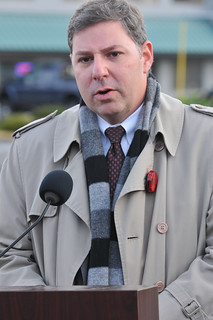The most powerful Oregon Department of Transportation employee in the area, Region 1 Manager Jason Tell, has now officially weighed in on the debate about a road diet on SW Barbur Blvd. Over the weekend, we obtained a letter (PDF) Tell sent to City of Portland Transportation Commissioner Steve Novick on Wednesday that details Tell’s current thinking about the idea.
The letter was dated September 25th and it was cc’d to the SW Corridor Plan Steering Committee, ODOT Director Matt Garrett, Oregon Transportation Commission Chair Pat Egan, and Governor Kitzhaber’s Transportation Policy Advisor Karmen Fore. This letter marks a significant step in awareness of the road diet with the powers that be within ODOT and among our state’s transportation decision makers.
So let’s look at what Tell wrote. First, some context…
Tell wrote the letter to Novick after the Commissioner spoke about the road diet during a live interview at City Club’s Friday Forum on September 20th. In that interview, Novick was asked whether or not he felt the City of Portland should push ODOT to make safety improvements on Barbur.
“We definitely will push them to study it,” Novick replied, “because we think it deserves serious consideration.” Apparently, that and other mentions of it from Novick spurred Tell to write the two-and-a-half page letter. Tell opened the letter by saying, “There has been considerable discussion and analysis of this issue in recent months that you may not be aware of.”
“Any road diet proposal would have to consider… the use of crash data to quantify and prioritize safety problems… There are no recorded crashes involving pedestrians or cyclists on the Vermont and Newbury Bridges over the past 10 years.”
—Jason Tell
Tell then shared some background on Barbur and explained its progress thus far within Metro’s Southwest Corridor Plan (the Barbur road diet is one of hundreds of project ideas that currently exist within the plan). Tell said the project has been discussed, but that it wasn’t selected for early implementation.
Tell’s central argument in the letter is that any effort to advance the Barbur road diet now, outside of the Southwest Corridor Plan — which is what he claims the Bicycle Transportation Alliance has requested — would, “leave out key stakeholders already at the table and disregard the comprehensive evaluation of high capacity transit options that will begin in October.”
Two things are notable about this aspect of Tell’s position: First, the BTA has never advocated for going outside the Southwest Corridor Plan process. They have simply urged ODOT to work with Metro and PBOT to study the traffic impacts the road diet would have. Also, the idea and concept for a road diet on SW Barbur came along way before the SW Corridor planning process got underway. In other words, there appears to be no technical reason why it must continue to be hitched to the SW Corridor Plan.
Another point Tell makes repeatedly in his letter is that whatever happens on SW Barbur, auto capacity cannot be reduced. “Improving walking, cycling, and transit options,” he wrote, “without reducing the capacity of Highway 99W has been a consistent message we’ve received from stakeholders.” He also writes: “As a state agency, ODOT would need to make sure that any decision that affects the capacity on Highway 99W is consistent with direction from the Oregon Transportation Commission and State Legislators.”
It’s worth noting that, according to their analysis of traffic modeling data, ODOT believes re-striping Barbur to include a bike-only lane on a 1.4 mile segment between SW Miles and Hamilton would lead to an unacceptable reduction of auto capacity (a finding that is disputed by both Metro’s own traffic engineer and an expert at Portland State University).
Along with no negative impact on auto capacity, Tell wrote that any road diet proposal put on the table would have to consider four things: crash data to “quantify and prioritize safety problems”; “the needs of all users”; the effect of traffic diverting onto other roads, and the interests of local leaders, business owners, and so on.
It’s notable that he put the need to demonstrate crash history atop that list. As in many cases where it’s very unpleasant to ride, many people simply avoid riding on Barbur due to safety concerns and those who do ride on it are very experienced “strong and fearless” riders. Nevertheless, Tell finishes his point at the end of his letter by writing, “There are no recorded crashes involving pedestrians or cyclists on the Vermont and Newbury Bridges over the past 10 years.”
Perhaps Tell believes the lack of reported crashes means there’s no safety risk at all and therefore the road diet is unnecessary?
One final note about Tell’s letter. He devotes two full paragraphs about the idea of transferring ownership of Barbur from ODOT to PBOT (known as a jurisdictional transfer). This appears to be a feasible solution if funding could be identified to make it happen.
In the end, Tell’s letter raises more questions than it answers. And on that note, I’m hoping to do some sort of Q & A with Tell to ask them. For now, brush up on your knowledge of this issue by reading Tell’s letter (PDF). And stay tuned. We expect more to report soon.


